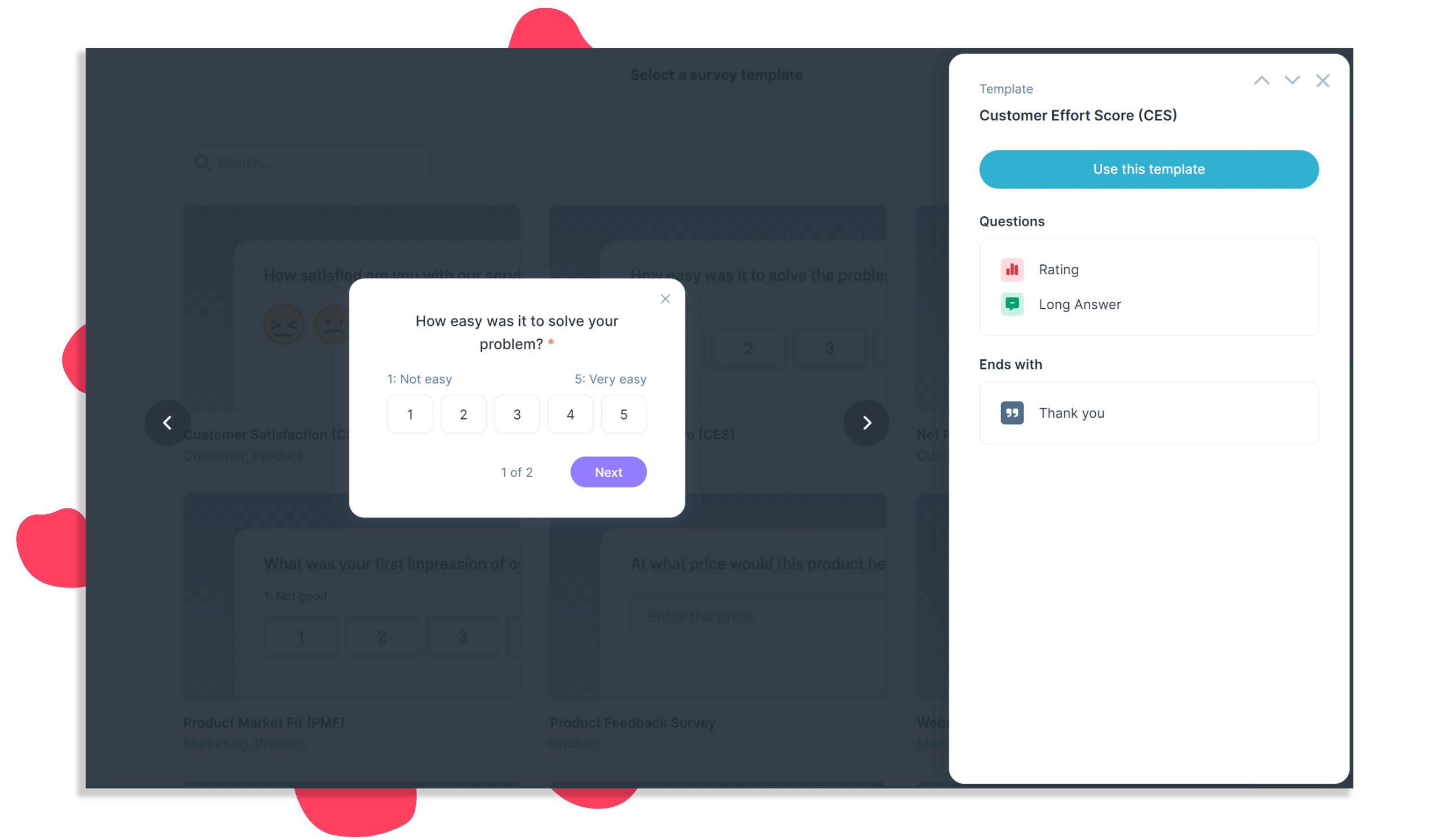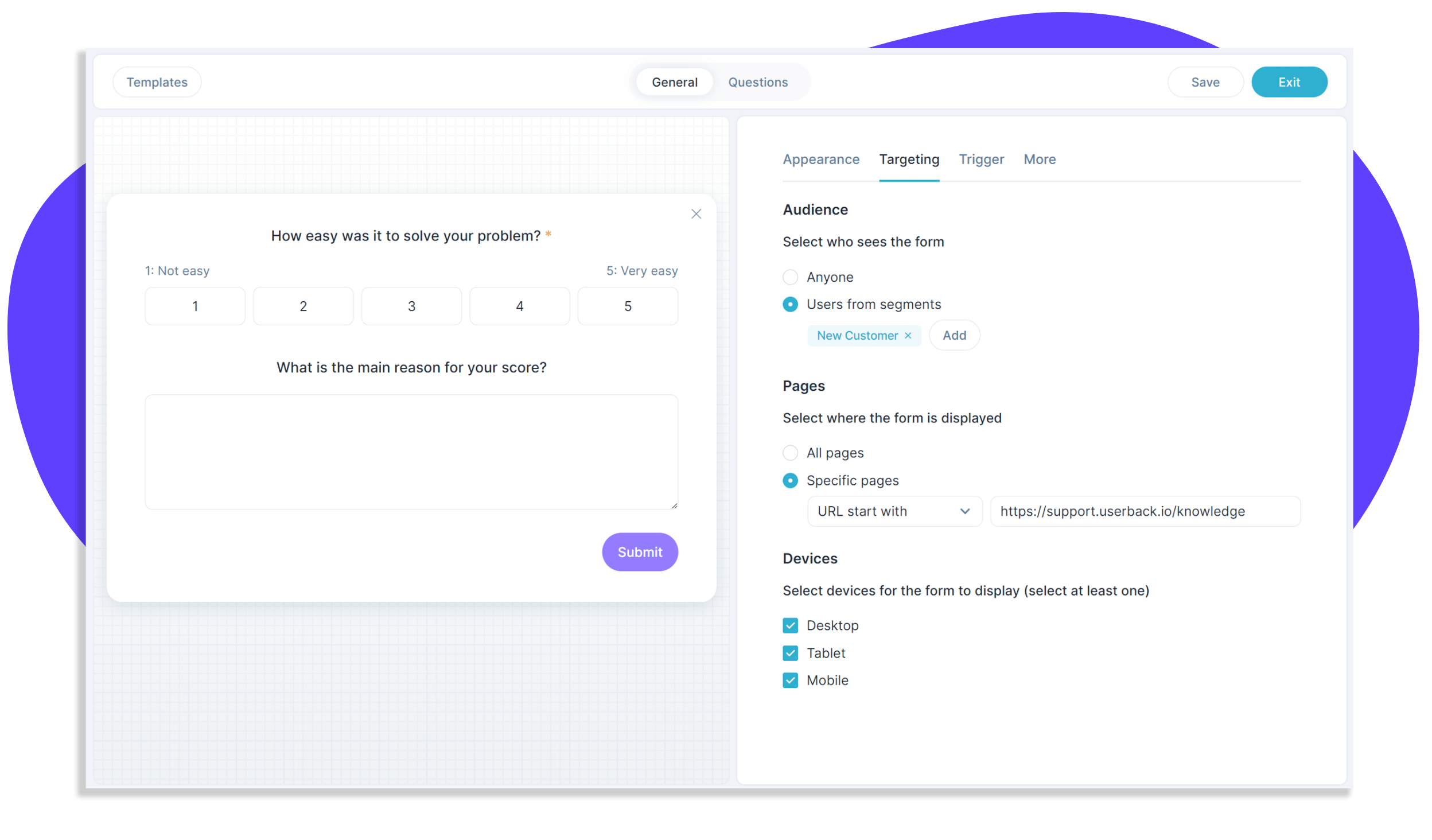
An Introduction to CSAT Surveys
Customer Satisfaction (CSAT) is the cornerstone of any successful business, reflecting how your customers perceive their experiences with your products or services. It’s not just a numerical score but a window into the customer’s journey and emotions regarding the entirety of their interaction with your brand. By leveraging targeted CSAT surveys, you can gain invaluable insights, allowing you to tailor your operations to meet and exceed customer expectations. This metric becomes a powerful tool for predicting future customer behavior, fostering loyalty, and identifying areas ripe for improvement. Employing CSAT effectively means that you’re not just chasing a rating; you’re building the foundation for long-term business success.
One thing to note early is the often confusing CSAT survey, and the similar, Net Promoter Score (NPS) survey. Whilst these too are similar to the uninitiated, the simplest explanation is that NPS is a measure of customer satisfaction, but specifically as a reference of referability. It’s a way to track the engagement of your brand as a whole, whilst the CSAT survey is designed to measure satisfaction with a particular function or aspect of a business. No that’s out of the way, let’s continue…
The Imperative of CSAT in SaaS Expansion
In the highly competitive SaaS industry, measuring customer satisfaction isn’t just another metric—it’s the pulse of your business’s health. An elevated CSAT score signifies that your software not only meets but exceeds user expectations, translating into powerful, organic growth through word-of-mouth endorsements and high customer retention rates. Let me lay out the facts for you:
Customer Retention: Happy customers are the lifeline of SaaS businesses. They not only continue to subscribe to your services but are also more likely to upgrade their plans. A study from Harvard Business School has stated that improving customer retention by just 5% can increase profits by 25% to 95%.
Product Refinement: Feedback from CSAT surveys provides direct insight into how users interact with your software. This knowledge is invaluable for innovating and refining your product to stay ahead of market trends.
Reduced Churn: By tracking CSAT, you can pinpoint dissatisfied customers and proactively address their concerns. This not only prevents churn but can turn a potentially negative experience into a positive one, reinforcing trust in your brand.
Enhanced Reputation: High satisfaction rates can bolster your brand’s reputation, leading to increased customer advocacy and expansion through referrals—an essential growth strategy for any SaaS platform.
Customization and Personalization: By measuring specific aspects of the user experience, CSAT allows you to tailor your services to align with customer needs, fostering a sense of personalization that today’s users demand.
Subscribers don’t just want a functional tool; they are looking for a solution that aligns with their goals and grows with them. By focusing on customer satisfaction, you’re not only enhancing their day-to-day operations but embedding your SaaS product as an indispensable asset for their business success. Equip your strategy with a robust CSAT measurement approach, and you’ll build a platform that’s indispensable, integrated, and imperative for your clients.

The Cornerstone of CSAT: What Makes a Great Survey
Key characteristics of effective surveys
The effectiveness of a CSAT survey hinges on the quality of its questions. The hallmark of a superior survey lies in its clarity, relevance, and conciseness. Here are the key characteristics that define highly effective CSAT surveys:
Clarity: Every question should be written in plain language, free from industry jargon, ensuring that nothing impedes the respondent’s ability to understand what is being asked. This avoids confusion and facilitates more accurate responses.
Relevance: Questions must be directly related to the customer’s experience. They should be tailored to gather insights on specific interactions to craft strategies that drive improvement in areas that truly matter to users.
Brevity: Keeping surveys short and to the point respects the customer’s time and increases the likelihood of survey completion. A shorter, well-constructed survey yields higher response rates.
Specificity: Vague questions breed vague answers. Questions should be specific enough to elicit clear, actionable feedback without guiding respondents to a particular answer.
Segmentation Capabilities: Effective surveys allow for customer segmentation, so you can analyze data based on demographics, user behavior, or subscription type to make targeted improvements.
Remember, every question in your CSAT survey should serve a purpose. Steer clear of redundant items that add no real value to your insights. Design every survey with the intent to uncover actionable data that empowers refined decision-making. By adhering to these principles, you’ll craft a survey that not only respects your customers’ time but also yields the insights necessary to elevate the user experience and drive SaaS expansion.
The Balance Between Simplicity and Informativeness in CSAT Surveys
Achieving an equilibrium between simplicity and informativeness in CSAT surveys is paramount for extracting valuable data without overburdening the respondent. Simple, easy-to-understand questions ensure a smooth experience that encourages completion, avoiding drop-offs that can result from overwhelming complexity. Yet, a questionnaire must also capture detailed, insightful feedback that reliably informs business strategies—this is where informativeness plays a critical role. The intersection of these two principles leads to high response rates and robust, nuanced insights that drive targeted, effective improvements. A masterfully balanced CSAT questionnaire becomes a beacon, guiding customer-centric enhancements with precision, ultimately fostering a dynamic where customers feel heard and businesses stay agile and informed.
Top 7 CSAT Surveys
1. The Classic Scale-Based Survey
Description and benefits: This traditional format asks customers to rate their overall satisfaction with your product or service on a scale, usually ranging from 1-5 or 1-10. It is simple, easy to administer, and provides a broad overview of customer sentiment. The scale allows for easy comparison and tracking over time, making it an effective tool for measuring changes in CSAT.
Sample question: On a scale of 1-10, how satisfied are you with our product?
Best used for: Gathering a general understanding of customer satisfaction and tracking overall changes in CSAT over time.
2. The Open-Ended Survey
Description and benefits: This format prompts customers to provide written feedback, allowing for more detailed and nuanced responses. It can uncover specific pain points or highlight areas of strength, providing valuable insights for targeted improvements. Additionally, open-ended questions allow for more personalization and provide opportunities for customers to share their unique experiences.
Sample question: Please share any feedback or suggestions you have regarding our product.
Best used for: Yielding detailed, qualitative insights and gaining a deeper understanding of customer needs and preferences.
3. The Multiple-Choice Survey
Description and benefits: This format presents customers with a set of options to choose from, providing a structured approach for gathering specific feedback. It allows for easy analysis and comparison across respondents while still allowing for some level of personalization through the variety of response options.
Sample question: Which feature do you find most valuable in our product?
Best used for: Identifying key features or areas that drive customer satisfaction and informing future development priorities.
4. The Net Promoter Score (NPS) Influenced Survey
NPS explained: The NPS is a widely-used metric for measuring customer loyalty and satisfaction. It involves asking customers how likely they are to recommend your product or service to others on a scale of 0-10. Customers are then divided into promoters (9-10), passives (7-8), and detractors (0-6). The final NPS is calculated by subtracting the percentage of detractors from the percentage of promoters.
Sample question: How likely are you to recommend our product to a friend or colleague?
Best used for: Evaluating overall customer loyalty and identifying areas for improvement in word-of-mouth marketing.
5. The Customer Effort Score (CES) Survey
CES explained: This metric measures how easy or difficult it is for customers to use your product or service. It involves asking customers how much effort they had to put in to achieve their goal using the product/service on a scale of 1-7. A low CES indicates a positive user experience, while a high CES suggests areas for improvement.
Sample question: How much effort did you have to put in to achieve your goal using our product?
Best used for: Understanding how user-friendly and intuitive your product/service is and identifying areas for streamlining processes or improving functionality. Ultimately, every CSAT survey questionnaire should be designed to elicit valuable insights that drive customer-centric improvements.
6. The Visual-Rating and Emoji Scale
Modern trends in CSAT surveys have shifted towards more visually appealing and interactive formats to engage customers. This format uses a range of emojis or graphics for customers to rate their experience, allowing for a fun and easy way to gather feedback. It also provides an alternative option for those who may not prefer traditional scale-based questions.
Sample question: How would you rate your overall experience with our product?
Best used for: Adding a touch of creativity and uniqueness to your CSAT survey, appealing to a wider range of respondents, and capturing data in a visually engaging manner. Ultimately, every CSAT survey questionnaire should be designed to elicit valuable insights that drive customer-centric improvements. By balancing simplicity and informativeness, you can create a powerful tool for understanding and enhancing
7. The Customized Hybrid Model
Combining multiple question types and approaches can provide a more comprehensive understanding of customer satisfaction. This hybrid model allows for a mix of open-ended, scale-based, and multiple-choice questions tailored to your specific business needs. It ensures both detailed feedback and easy analysis while also allowing for customization based on unique customer segments or product features.
Sample question: How satisfied are you with our customer service? Please rate on a scale of 1-10 and share any additional feedback in the space below.
Best used for: Businesses looking to gather detailed, specific insights while also tracking overall satisfaction levels and identifying key areas for improvement. This model provides flexibility and depth in understanding customer needs and preferences. Ultimately, every CSAT survey should be designed to elicit valuable insights that drive customer-centric improvements. By utilizing a variety of formats and approaches, you can create a powerful tool for understanding and enhancing the overall customer experience. Ultimately, it is important to regularly review and update your CSAT survey to ensure its effectiveness in gathering meaningful feedback and driving positive changes within your business.

Integrating Surveys with Business Strategies
Leveraging CSAT survey data is a strategic asset for product teams aiming to drive innovation and refine user experiences. By meticulously analyzing this trove of customer feedback, teams can identify trends and patterns that reveal the strengths and weaknesses of their offerings. Positive testimonials spotlight features that resonate well with users, guiding the team in underlining these as key selling points. Conversely, any recurring issues become apparent targets for improvement.
Spotlight Success: Utilize numerical ratings and positive testimonials to reinforce your product’s effectiveness and reliability. Employ these insights to tailor marketing messages and celebrate what customers love most about your product.
Prioritize Enhancements: Address the specific pain points reported by users to inform your product roadmap. Integrating customer feedback into development priorities ensures that enhancements are aligned with user needs, fostering a user-centric design and development approach.
Customize Experiences: Analyze the nuanced feedback from open-ended questions to enable personalization. Tailoring experiences to meet the individual needs of different user segments can significantly boost customer satisfaction and loyalty.
Predict Trends: Observe changes over time to predict customer needs and proactively innovate before your users even ask. Spotting trends early allows product teams to be at the forefront of the market, offering solutions ahead of competitors.
Streamline Usability: Apply findings from the CSAT survey to simplify processes and increase the product’s ease of use. An intuitive user experience translates to higher customer satisfaction and reduces friction, leading to better retention rates.
By embracing a continuous feedback loop and incorporating these insights into the decision-making process, product teams can transform CSAT data into significant competitive advantages, ensuring that every update and new feature hits the mark with their target audience.
Boosting Response Rates: Tips and Tricks
Maximizing customer engagement in CSAT surveys begins with timing and pertinence. When customers are immersed in using your application—right at the peak of their engagement—is when you should trigger a CSAT survey. This strategy ensures that their experience is fresh in their minds, prompting responses that are both immediate and genuine.
In-App Triggering: Deploy surveys within the app environment, leveraging specific triggers such as the completion of a task or a transaction. Seamless in-app surveys offer convenience, making it easier for users to share their feedback without disrupting their flow
Relevance and Segmentation: Tailored prompts to specific user segments significantly increase response rates. By filtering who receives your survey based on their interaction history, you deliver a more personalized inquiry, demonstrating that their individual experience is valuable to you.
Keep it simple: Long, complex, and time-consuming CSAT surveys are going to leave even the best product team with partially complete, abandoned surveys as users quit early to continue the task they arrived to do. By deliberately limiting question complexity and volume, a quick, concise survey can be completed with minimal disruption to users.
If all else fails, incentivize: It’s no disgrace to have to resort to incentivizing responses. An intro to your survey pop-up promoting a gift or giveaway can increase your response rate significantly. Combine this strategy with portable survey links, those that go from in-app pop-ups, to email links to add to your response numbers.
By strategically positioning your requests for feedback as part of the user’s journey, and ensuring only those most engaged receive them, you not only respect their time but also enhance the likelihood of achieving insightful, actionable data to guide your enhancement strategies.
Case Studies: Success Stories of CSAT in Action
A. Zappos: The Customer Service Champion
Zappos, an online shoe and clothing retailer, has long been heralded for its exceptional customer service. Their investment in CSAT surveys paid off when analysis of customer feedback revealed a desire for more personalized service. By empowering their customer representatives to take ownership of customer queries, Zappos not only saw an increase in CSAT scores but also a corresponding boost in customer loyalty and repeat business.
B. JetBlue: Soaring to New Heights with Customer Feedback
JetBlue Airways took its CSAT data to heart by implementing a real-time feedback system, allowing them to address concerns promptly. This timely approach to customer dissatisfaction translated to a commendable turnaround in service perception. As a result, JetBlue has consistently outperformed competitors in satisfaction rankings, a testament to the effective use of CSAT data in operational improvements.
C. Slack: Streamlined for Satisfaction
Slack’s rise to dominance as a communication platform can be partly credited to its obsessive focus on customer feedback. By diligently tracking CSAT scores, they identified and addressed specific user interface frustrations, rolling out updates that enhanced the overall user experience. The positive changes in their CSAT scores were paralleled by rapid user growth and improved customer retention rates.
Start Using CSAT Surveys Today
Selecting the right CSAT (Customer Satisfaction Score) survey is critical to obtaining actionable insights that propel product growth and customer satisfaction. It’s all about asking the right questions at the right time in a manner that’s accessible to users. The most effective approach lies in targeted in-app surveys, which mesh seamlessly with customer interactions. These surveys capture the voice of the customer during peak engagement moments, resulting in high-quality feedback that is both relevant and immediate.
Utilizing in-app triggers like completing a milestone activity ensures that surveys are opportune and contextual, encouraging users to share their honest opinions without breaking stride. Moreover, with an intelligently designed CSAT tool, customization options abound, allowing you to reflect your brand’s unique voice and personality even in the feedback process. In practice, this focused method leads not just to increased response rates but also provides a wealth of nuanced data that can translate directly into strategic improvements, fostering a loyal user base and a product that continuously evolves to meet and surpass customer expectations.
Explore how you can create winning CSAT surveys with Userback for free, or if you still feel you need help to get it started, book a 30-minute demo with our CSAT survey experts.
